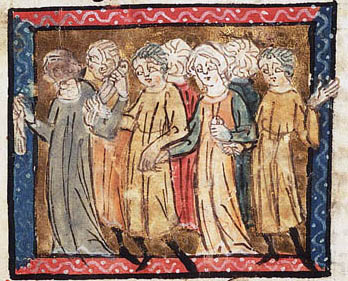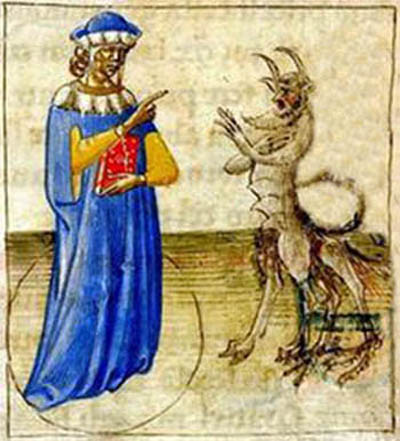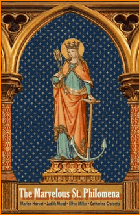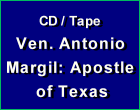Stories & Legends
 |
 |
 |
 |
 |
 |
 |
Heretics Worked Miracles by the
Aid of the Devil
Caesar of Heisterbach (1180-1250) was Master of the Novices and Prior in the Monastery at Heisterbach. His Dialogue was one of the commonest sources for sermon-stories. The object of these sermon stories was to arouse interest and to convey moral truths.
Here he exposes an evil we experience often today: False visionaries who pretend to great signs and miracles but spread bad doctrine and heresies.
Two men simply clad but not without guile, not sheep but ravening wolves, came to Besançon, feigning the greatest piety. They were pale and thin, they went about barefooted and fasted daily; moreover, they did not miss the Matins in the Cathedral a single morning, nor did they accept anything from anyone except a little food.
Here he exposes an evil we experience often today: False visionaries who pretend to great signs and miracles but spread bad doctrine and heresies.
When by such hypocrisy they had attracted the attention of everyone, they began to vomit forth their hidden poison and to preach to the ignorant new and unheard of heresies. In order, moreover, that the people might believe their teachings they ordered meal to be sifted on the sidewalk and then they walked on it without leaving a trace of a footprint. Likewise, walking upon the water, they could not be immersed. Also, they had little huts built and entered them; then, after those had been burned to ashes, they came out uninjured. After all this, they said to the people, “If you do not believe our words, believe our miracles.”

The people were amazed by the new preachers
Now that Bishop was a good and learned man and a native of our province. Our aged Monk Conrad, who told me these facts and who was in that city at the time, knew him well.
The Bishop seeing that his words were of no avail and that the people entrusted to his charge were being subverted from the Catholic Faith by the Devil's agents, summoned a certain clerk who was very well versed in necromancy.
The Bishop told him, “Certain men in my city are doing so and so [describing their feats]. I ask you to find out from the Devil who they are, by means of your art, whence they come, and by what means so many and so wonderful miracles are wrought. For, it is impossible that they should do wonders through divine inspiration when their teachings are so contrary to God’s.”
The clerk said: “My Lord, I have long renounced that art.”
The Bishop replied, “You see clearly in what straits I am. I must either acquiesce in their teachings or be stoned by the people. Therefore, I enjoin upon you for the remission of your sins that you obey me in this matter.”
The clerk, obeying the Bishop, summoned the Devil, and when asked why he had called him, the clerk responded: “I am sorry that I have deserted you. And because I desire to be more obedient to you in the future than in the past, I ask you to tell me who these men are, what they teach, and by what means they work so great miracles.”
The Devil replied, “They are mine and sent by me, and they preach what I have placed in their mouths.”
The clerk responded: “How is it that they cannot be injured, or sunk in the water, or burned by fire?”
The Devil replied again: “They have under their arm-pits, sewed between the skin and the flesh, my compacts in which their homage to me is written. It is by virtue of these that they work such miracles and cannot be injured by anyone.”

The clerk summons the Devil
The Devil replied: “Then, they would be weak, just like other men.”
The clerk, having heard these words, thanked the Devil, saying: “Now go, and when you are summoned by me, return.”
He went to the Bishop and recited these things to him.
The latter, filled with great joy, summoned all the people of the city to a suitable place and said: “I am your Shepherd, ye are my sheep. If those men, as you say, confirm their teaching by signs, I will follow them with you. If not, it is fitting that they should be punished and that you should penitently return to the Faith of your fathers with me.” The people replied: “We have seen many signs from them.”
The Bishop replied: “But I have not seen them.” And he proposed that the heretics should be brought forth to demonstrate their wondrous works.
The plan pleased the people. The heretics were summoned. A fire was kindled in the midst of the city. Nevertheless, before the heretics entered it, they were secretly summoned to the Bishop. He said to them: “I want to see if you have any evil object on your persons.”
Hearing this, they stripped quickly and said with great confidence: “Search our bodies and our garments carefully.”
The soldiers, following the instructions of the Bishop, raised their arms and, noticing under the arm-pits some scars that were healed up, broke them open with their knives and extracted from them the little scrolls that had been sewed in.
Having received these, the Bishop went forth with the heretics to the people and, having commanded silence, cried out in a loud voice: “Now shall your prophets enter the fire, and if they are not injured I will believe in them.”
The wretched men trembled and said: “We are not able to enter now.”
Then the Bishop told the people about the evil that had been detected and showed them the compacts. Then, all became furious and hurled the Devil's ministers into the fire that had been prepared, so that they might be tortured with the Devil in eternal flames.
And thus, through the grace of God and the zeal of the Bishop, the growing heresy was extinguished and the people who had been seduced and corrupted were cleansed by penance.

Excerpt from Caesar of Heisterbach, Dist. V, chap. 18, vol. 1, pp. 296
in Translations and Reprints from the Original Sources of European History,
University of Pennsylvania Press (189?-1907), vol. II, n. 4, pp. 7-11
Posted October 25, 2014
in Translations and Reprints from the Original Sources of European History,
University of Pennsylvania Press (189?-1907), vol. II, n. 4, pp. 7-11
Posted October 25, 2014






